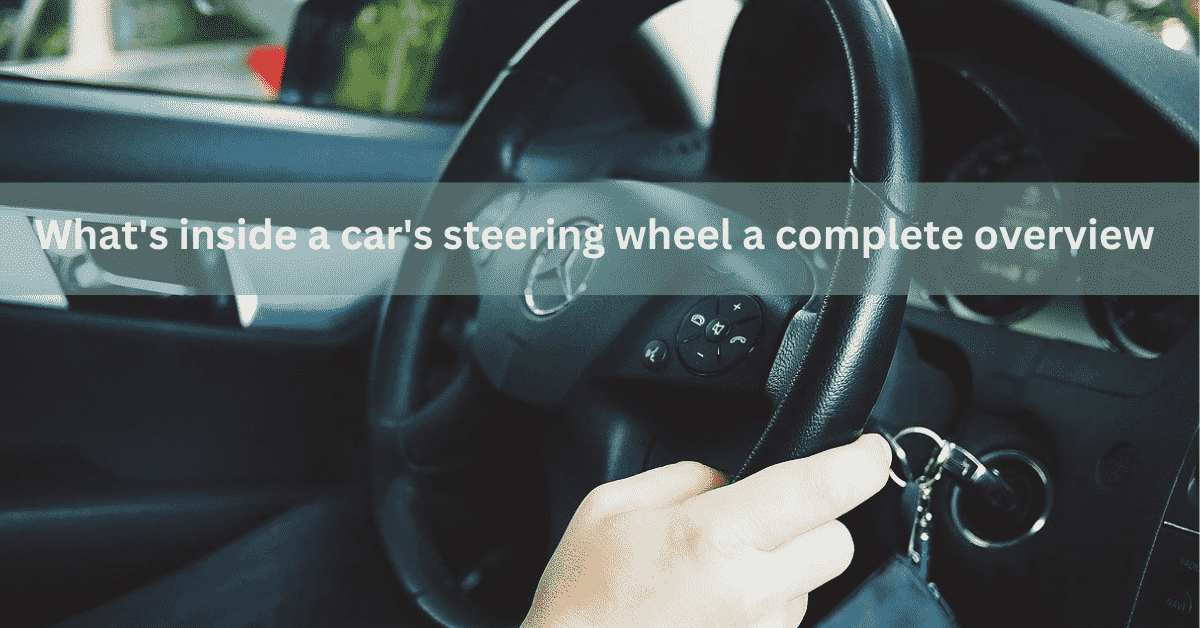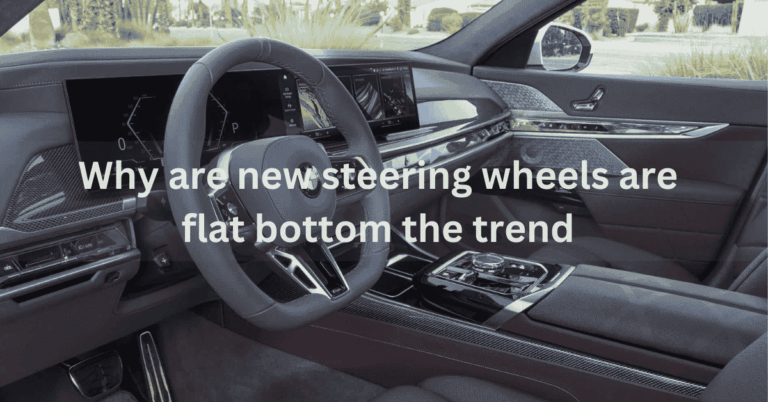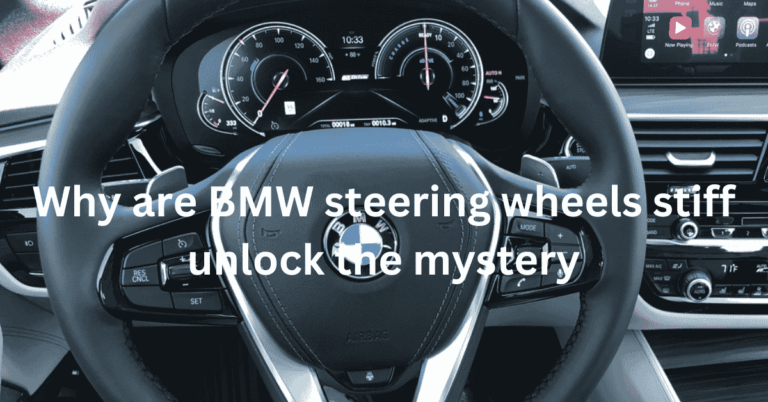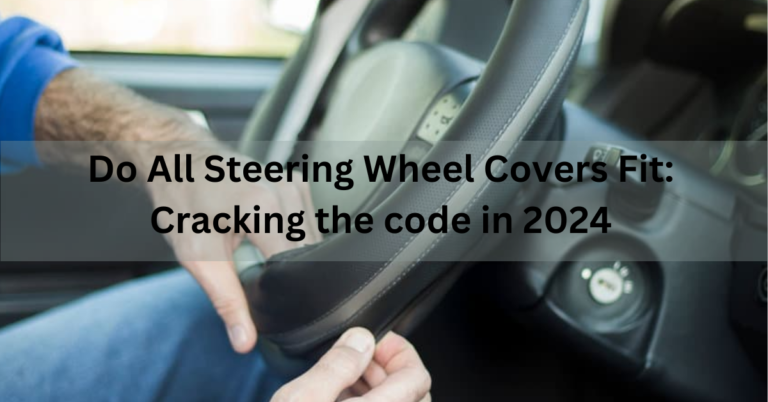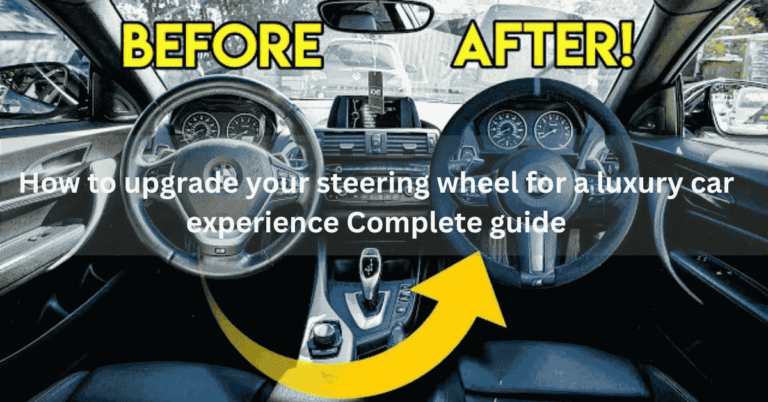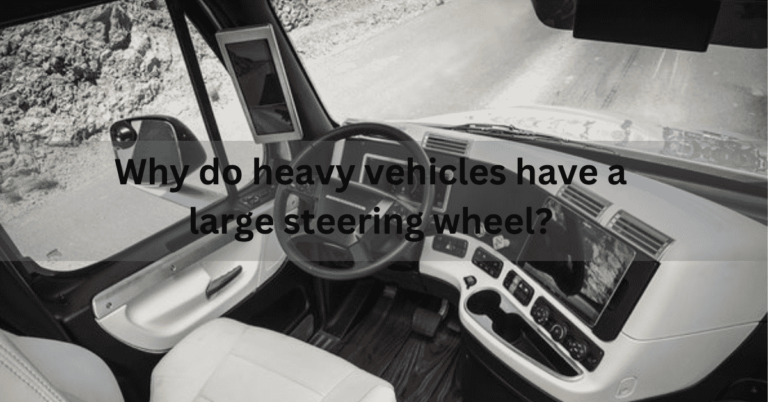What’s inside a car’s steering wheel? complete overview in 2024
The steering wheel is the primary way through which the driver interacts with the car. It allows drivers to steer the vehicle and change direction.
Each of these parts plays a crucial role in the steering wheel’s proper functioning. Ultimately it assures the cars and drivers’ safety.
The driver can make turns when needed. It makes driving safe and efficient.
In this blog, I will give a complete overview of what’s inside a steering wheel. After reading this you’ll be able to know every part of the steering wheel and its importance.
Read below:
What’s inside a car’s steering wheel?
You must be curious about what’s inside a car’s steering wheel. A car’s steering wheel is made up of several components. The steering wheel is an essential feature of a vehicle.
It includes the steering column, steering wheel cover, horn button, and airbag module. And also the wiring harness and steering wheel controls.
parts of a Car’s Steering Wheel
- Steering column:
The steering column is a part of the steering wheel. It is a vertical shaft that connects the steering wheel to the car’s steering mechanism. Its main function is to send the driver’s steering input to the steering mechanism. As a result, it turns and controls the car’s direction.
- Steering wheel cover:
The steering wheel is a cover used to protect the steering wheel from dust. It is like a protective layer that purpose to cover the steering wheel surface. It helps to give a comfortable grip to divers. It also prevents the driver’s hands from the steering wheel.
- Horn button:
The horn button is so major part of the steering wheel. Its purpose is to transmit the signal to other people. They may be another driver or any person on the road. The horn button is placed in the center of the steering wheel. When the driver pressed it the crass horn activated. It is mainly a safety feature which alerts the other people.
- Airbag module:
The Airbag module is a safety and protection feature.it is designed to protect the driver in case of an emergency. It is also located in the center of the steering heel. It deploys suddenly when the sensors detect any collision.
- Wiring harness:
It’s a bundle of wires that connect to the various features of the steering wheel. The wiring harness is used in the car’s electrical system.
It helps to steering wheel control to transmit and communicate with the car’s computer system. It enables the airbag and horn buttons to function correctly at the right time.
- Steering wheel control:
The steering wheel controls are a set of switches and buttons that are placed on the steering wheel surface.
It helps the driver to control the various functions of the car. Like as cruise control, audio system, and phone connection.
The driver doesn’t need to move their hands from the steering wheel. While using this main feature of the car.

Also Read:
Is A Heated Steering Wheel Warm All The Way Around? The Truth Revealed
Why Do Heavy Vehicles Have A Large Steering Wheel? Complete Guide In 2024
The Function of a Steering System
The function of the steering wheel is to enable the drivers to control the direction of a vehicle. It is a major mechanism that holds car functionality and safety.
It consists of various components like a steering wheel, steering column, and steering gear. The other safety features such as the airbag module and airbag also part of the steering wheel.
When you drive the car you must think about how this works. The reason behind this smoothness of the driving.
There is a technical and scientific approach that I will discuss in this section. The steering system works by translating the rotational motion of the steering wheel. It conveys linear motion that is transmitted to the wheel.
When you turn the steering wheel it rotates the steering column which is connected to the steering gear.
The steering gear then changes the rotational motion into linear motion which moves the tie rods.
The tie rods are attached with wheels and then it move. The movement causes the wheels to turn right or left depending on the direction of the steering wheel.
In which movement you move the steering wheel the tore moves towards. That is how it is working.
The steering system’s importance is remarkable. We can’t imagine to control the vehicle without a steering system.
A malfunctioning of the steering wheel leads the driver to the accident. So it is advised to do regular maintenance of the steering wheel.
It will ensure the reliability and safety of the vehicle and yourself.
The Rack-and-Pinion System
The rack and pinion system are major features in functioning the steering wheel. It is a mechanical device used for transforming rotational motion into linear motion.
As I discussed in the previous section how the steering wheel works. By changing the rotational signal into linear motion. and the steering wheel reacts according to these signals.
The rack and pinion is the main function. The gear(known as the pinion) and linear toothed bar9is rack).
The pinion gear is connected to the rotational source like an electric motor. While the rack is fixed in one space.
When the pinion gear rotates it connects to the rack. it causes the linear movement of the rack. This motion can be used for various functions like controlling the movement. It controls the steering wheel of a vehicle.
Advantages of rack and pinion:
- The rack and pinion also signify efficiency and simplicity.
- It consists of fewer parts than other mechanical devices.
- This makes sit easier to maintain and lightweight.
- It also helps to provide smooth and reliable motion.
- this is crucial for precise steering in vehicles.
Disadvantages of rack and pinion:
- It is susceptible to wear and tear.
- The constant use of the gear and rack can cause wear out over time.
In my opinion, the rack and pinion system is the best invention in the area of mechanism. It provides a simple and effective conversion of rotational motion into linear motion.

The Steering-Box System
A steering box system is a mechanical feature that is used in vehicles. It helps to transmit the driver’s input from the steering wheel to the wheel of the vehicle.
It consists of a gearbox which is commonly known as the steering box or gear mechanism. It is used to convert the rotational motion of the steering wheel into linear motion. It moves the wheel right or left.
It works:
- Steering input:
When the driver turns the steering wheel, it rotates the shaft attached to the steering box.
- Worm gear and sector gear:
The steering wheel mainly contains worm gear on the steering wheel shaft. The sector gear is connected to the vehicle’s steering wheel linkage.
- Conversion of motion:
As the pinion gear turns it connects with the teeth of the rack. It gives the rotational motion and converts it into linear movements.
- Steering linkage:
The linear movement transmitted to the car’s front wheel. it uses rods and linkages to convey the message. Then the wheel turns in the desired direction.
| Advantages | Disadvantages |
| Simple design: The steering box system consists of various mechanical features. But it has a simple and reliable design. | Limited adjustability: The steering box system may have limited adjustability. |
| Easy for maintenance: When we compared it to other mechanical features.it is easier to maintain and repair. | Potential overtime: Over time due to wear and tear it loses precision. |
| Direct feel: Some drivers need the direct mechanical feel of the steering box system. | Weight and size: The steering box can be heavier and take up extra space. When compared to modern alternatives. |
These simple insights will help you to find reliability and simplicity. But when considering the device know the advantages and drawbacks for overall performance.

Working of a Power Steering Mechanism
A Power steering mechanism is a system in the vehicle. it is designed to help the drivers in steering the vehicle. Mainly in low-speed turns and heavy steering efforts.
It uses hydraulic and electric mechanics to augment the force given by the driver on the steering wheel.
It helps to make it easier to control the direction of the vehicle.
Hydraulic power steering:
- A pump powered by the engine and pressurized hydraulic fluid.
- The hydraulic cylinder gets this pressurized fluid. it is also known as a power steering rack and pinion.
- Then the hydraulic cylinder helps the wheel to turning the wheels. The driver applies force on the steering.
Electric power steering:
- Electric power steering is a modern mechanism used instead of hydraulic fluid.
- This electric motor assists the sensors. The sensors detect the steering input given by the driver.
- Then the electric motor adjusts the amount of pressure.
- making steering easier at low speeds and providing better stability at higher speeds.
Advantages and disadvantages:
Advantages:
- Reduced steering effort:
Power steering reduces the physical effort of the driver. It easily turns the steering wheel, mainly at low speed.
- Enhanced control:
This enhances the driving experience by giving responsive control. It improves handling and smoothness on the road.
- Driver comfort:
Due to less effort in steer. The driver experiences comfort during driving. It reduces the fatigue.
Disadvantages:
- Cost:
The power steering system needs more manufacture and repair. So it is costly for vehicles with power steering.
- Maintenance:
Hydraulic power steering needs more maintenance. because it has fluid init which can leak or degrade over time.
- Dependency on power:
The electrical power steering system depends on the vehicle’s electrical system. A failure in the electrical components may affect the electric steering.
The difference between a Power Steering and a Manual Steering
Wheel needs the direct force of the driver. It relies on the physical effort of the driver to turn the wheel.
In a manual steering system, there is a direct connection between the wheels and the steering wheel. It requires the driver forced to turn the car.
Advantages and disadvantages of manual steering:
Advantages:
- Simplicity:
As the name suggests manual steering is simple and has fewer components. Its simplicity makes it easier for us and less costly.
- Direct connection:
Some driver needs direct feed back given by manual steering. It allows drivers to be more connected driving.
Disadvantages:
- Effort required:
It is a sole depends on driver effort that why it requires effort from the driver.
- Less convenient:
In parking or heavy traffic the lack of power assistance. You may feel it is less convenient.
Comparison between power steering and manual steering:
| Aspects | Power steering | Manual steering |
| Assistance mechanism | Electric or hydraulic power assistance. | Direct mechanical link |
| Steering effort | reduces the effort of the driver during turns. | It needs more physical effort from the driver’s side. |
| Convenience | It is convenience for driver to turning tight spaces. | Less convenience mainly in parking. |
| Maintenance and complexity | Need more maintenance and have a complex system. | It has a simple design and needs less maintenance. |
| Driving feels | It gives less direct feedback. | It provides a connected and direct driving feel. |
The choice is yours both power steering and manual steering have their benefits. each depends on factors like your preference, use of the car, and the driving condition.
Power steering offers effortless and convenient driving. while manual steering gives a more hands-on driving experience.

Also Read:
Benefits Of A Heated Steering Wheel In Cold Climates In 2024
Types of Power Steering
Power steering offers various options for different driving preferences. Here are three main types of power steering:
- Hydraulic power steering
- Electric power steering
- Electro-hydraulic power steering
Hydraulic power steering:
It is a traditional system of power steering that depends on the hydraulic fluid to assist in steering. A pump pressurizes the fluid then it making steering responsive and smoother.
Electric power steering:
It is a technological replacement for the hydraulic system. It connects with an electric motor. This motor is located on the steering column. It directly gets a signal in the steering.
It is easily integrated with another vehicle system which enhances the overall driving experience and control.
Electro-hydraulic power steering:
Electro-hydraulic power steering is a combination of both systems. It combines the features of both hydraulic and electric power steering.
It uses the hydraulic fluid to transmit the power but an electric motor controls the hydraulic pump.
This scientific approach aims to provide the benefits of both systems. it offers responsible steering with energy efficiency.
Each type has its advantages and styles. But it depends on your style of driving and experience which one is suite for you.
Electric Power Steering vs Hydraulic Power Steering
Advantages and disadvantages of electric power steering:
Advantages:
- Energy efficient:
The electric power steering wheel is energy-powered. It only consumes energy when it is needed. It also improves fuel efficiency.
- Variable assistance:
It gives an adjustable steering level. A driver can enhance turning at low speed and stability at high speed.
- Easy for maintenance:
It requires less maintenance than hydraulic steering. You can easily maintain it and also easy to use.
Disadvantages:
- Limited feel:
When you use it you feel that you have a limited connection to the road. because its electrical power lacks feedback to the driver.
- Complexity:
These electrical systems are complex and more expensive. When the issue comes in you need extra effort to repair it.
- Dependency on the electrical system:
This system relies on the vehicle’s electrical system. If the car’s electrical system is failed the steering will also face challenges.
Advantages and disadvantages of hydraulic power steering:
Advantages:
- Road feel:
Hydraulic power steering gives a direct feel to the road. It offers a better sense of connection between the driver and the road.
- Proven technology:
These systems are proven by millions of drivers. It has been used for decades in cars. That’s why these are is known for their durability and simplicity.
- Simplicity:
Hydraulic power steering wheels are simple in design. This makes steering maintenance and repair more easy.
Disadvantages:
- Energy consumption:
Hydraulic power is less energy efficient and consuming power.
- Fluid leaks:
The hydraulic system can leak fluid. That’s why it needs regular maintenance to avoid any risk.
- weight:
These systems are heavier than electric systems. It needs more attention from the driver. But due to its reliability driver can use it through decades.
Comparison between electric power steering and hydraulic power steering:
| Aspect steering | Electric power steering | Hydraulic power |
| Energy efficiency | It is more energy efficient. it consumes power from the electric motor. | It is less energy efficient and needs more power. |
| Steering feels | It is not given a good connection between the road and drivers. | It is meant to provide a constant connection between drivers and the road. |
| maintenance | It needs less maintenance. | It has a simple design that needs more maintenance. |
| Repair costs | It can be more complex and need more repair costs. | It has a simple system that needs affordable cost to repair. |
| Dependence on the electrical system | relies on the vehicle’s electrical system. | It does not depend on the electrical system. |
These are simple comparisons between electric power steering and hydraulic power steering. But choosing between them depends on your personal choice of driving style.
These both are reliable and efficient in their terms and conditions. Check your car model then make a decision.
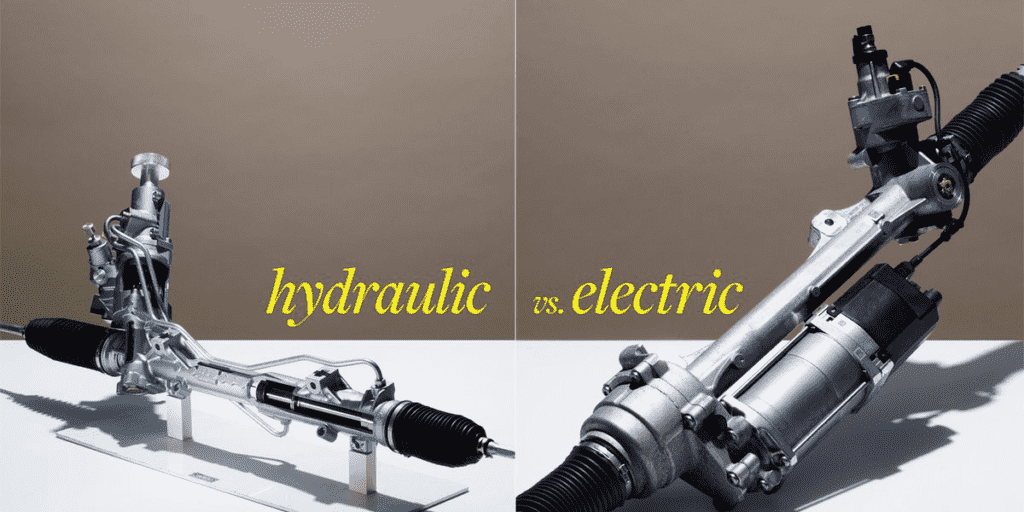
What are Steering Wheel Controls
Steering wheel controls are buttons that are set on the steering wheel of a car. These refer to switches and buttons for different purposes.
It provided a convenient way for the drier to operate different functions without any hassle.
You cannot take your hand off the steering wheel while using these features.
These buttons include audio settings, phone operators, cruise control, and other important features. It enhances convenience and ensures safety.
How do they work?
Steering wheel controls mostly operate from a wireless or wired connection. These wires are connected to the car’s electronic system.
Wired controls connect through a physical connection to transmit signals. While wireless use technologies like Bluetooth an radio frequency.
When you press a button on the steering wheel it sends a signal to the car control module. It activates the function.
This feature allows drivers to modify settings and access features. Without changing their attention from the road.
Advantages and disadvantages:
Advantages:
- Enhanced safety:
Steering wheel control is useful for safer driving by reducing distraction. The driver easily reaches the dashboard cntrl which minimizes the risk.
- Convenience:
Easily accessible control provides more convenience to various functions. It promotes a smoother driving experience.
- Improved ergonomics:
Due to the control on your fingertips adjusting settings becomes more ergonomic. It ensures a comfortable driving position.
Disadvantages:
- Leaning curve:
Some drivers find adapting to the palace and functions take time. Reaching to steering wheel controls leads to a leaning curve.
- Repair complexity:
If the steering control function diagnoses any issue. It takes more complex to repair than traditional switches.
- Limited customization:
These vehicles may have limited customization options for steering wheel control. This feature may not suit everyone’s reality.
Steering wheel control comes with various benefits like safety and convenience. But also have some disadvantages such as a potential leaning curve and repair problems.
The overall choice of choosing them is based on your personal preference and driving experience.
Types of Steering Systems
Mainly there are four steering system types. These steering systems are widely used by many drivers.
But to choose one from them is based on your need driving style.
- Recirculating Ball Steering.
- Worm and Roller Steering.
- Cam and lever steering.
- Rack and pinion system.
Recirculating Ball Steering:
These types of steering systems work with a gear mechanism that has a ball bearing. That is recirculated through the gears.
As the steering wheel turned the ball bearing moved the gear. In reaction, it moves the pitman arm and steering linkage to turn the wheel.
The recirculation sterling system is mostly used in heavy vehicles like trucks and SUVs.
Worm and roller steering:
This system is similar to the recirculating ball steering. But it did not use a ball bearing, it uses rollers that move along a worm gear.
The steering wheel turns the worm gear,it moves the roller and the steering linkage to run the wheels.
Worm and roller steering systems are used in small vehicles like cars and light trucks.
Can and lever steering:
This type of steering system uses a cam and levers to convert the rotational motion into linear motion. This movement of the steering wheel turns the wheel.
Cam and lever are not commonly used in modern cars or any vehicle.
Rack and pinion steering:
This is the most commonly used steering system in modern cars.
It uses a rack and pinion gear mechanism and converts the rotational motion into linear motion that turns the wheel.
The pinion gear is connected to the steering shaft and turns as the steering wheel moves.
The pinion gear netting with the rack gear which moves the tie roads and turns the wheel.
Rack and pinion steering is best known for its responsive and precise handling.
Frequently asked question
1. What are the parts inside the steering wheel of a car?
Inside the steering wheel of a car, you find an airbag module, wiring for the horn, and other controls. And a rotating contact for electrical connections.
2. What are the 4 major components of a steering system?
The four major components of the steering system are
- Steering wheel.
- Steering column.
- Steering gearbox.
- Tie rods.
3. What’s inside a steering column?
Inside a steering column, you see a combination of gears, shafts, and linkages. That helps to transfer the motion from the steering wheel to the steering gearbox or rack.
4. What is the car steering column called?
The car steering column is called the steering column.
5. What is a steering gearbox?
A steering box is a mechanical components that convert the rotational motion into linear motion. Ithelping to steer the wheel.
6. What is a steering rack?
A steering rack is a part of the steering wheel system which consists of s toothed bar and pinion gear. it converts rotational motion into linear motion and turns the wheel.
Conclusion:
There are four types of steering wheel systems. Recirculating ball, worm and droller, cam, and lever and rack a pinion.
The choice of steering system is based on the car type and model. And more importantly your choice style of driving and need.
All have their unique advantages and disadvantages.
Happy driving

